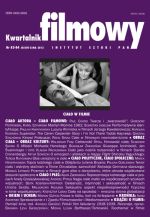
Cielesność, intymność i seksualność w filmach Ulricha Seidla jako medium samotności i odrzucenia
Austrian director Ulrich Seidl says that all his films are physical, because – in his opinion – it is important to make films physical and attract viewers to characters as close as possible. Kosińska-Krippner follows in his work various ways in which issues of corporeality and sexuality are grasped – including the use of an image of body as a tool of provocation or making the image of corporeality a specific medium of expressing reflection on man and the world, which he creates around himself. The director shows the body in its various facets and aspects, sometimes running away from its visual presentation, limiting himself to the verbal sphere and sometimes he dazzles us with physicality, nudity, debauchery and perversion, in order to tell us more about the human nature. Seidl shows his characters in the most intimate of situations, he looks at society without compassion, and leaves the evaluation to the viewers. He mercilessly exposes the ugliness of human existence, diagnoses the psyche (soul) of the modern man and the condition of his world and human relationships, showing what humans do with their own bodies and how they treat the bodies of others. The director robs the viewer of the illusion that normalised (prosperous) society and the dregs of society are distant and separate worlds.
More...